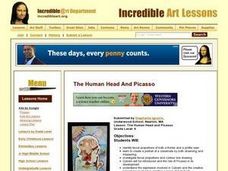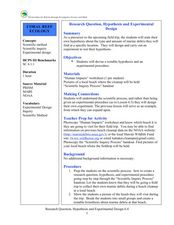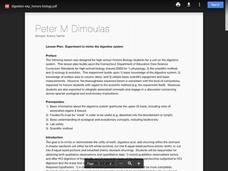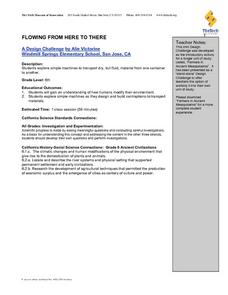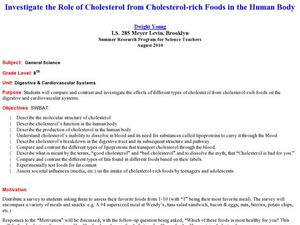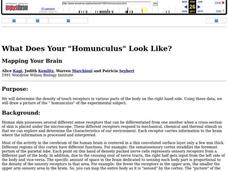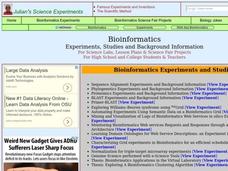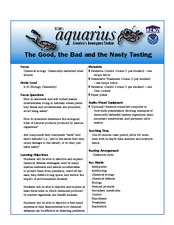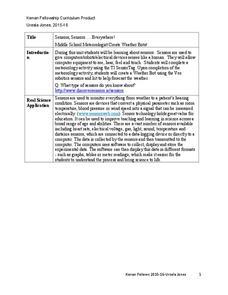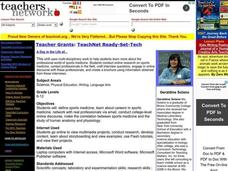Curated OER
The Human Head and Picasso
Sixth graders view human head paintings by Picasso. Using the paintings, they identify the facial proportions by a frontal and profile view. With a partner, they create a portrait of them after observing and measuring their face. They...
Curated OER
Research Question, Hypothesis and Experimental Design
Students discuss steps of the scientific process, as well as, observe a picture of the beach that they will visit. Students create a testable hypothesis about marine debris at the beach. In this science lesson, students create a...
Curated OER
The Nutrients Public Transportation System
Students investigate the human circulatory system by experimenting with hoses. In this human body lesson, students create a system of hoses simulating the circulatory system which they utilize to pass objects through....
Curated OER
Systems of the Body: Movement and Choreography
Students create movements that connect art and science. In this body systems lesson plan, students interpret the function of body systems, organs, and processes as they create movements to exhibit their research findings.
Curated OER
Beach Cleanup at a Local Beach
Students participate in an environmental clean-up activity. In this environmental instructional activity, students travel to a local beach. Working in small teams, students collect trash from the local beach. Returning to school,...
Curated OER
Experiment to Mimic the Digestive System
Students demonstrate how digestion occurs. In this biology instructional activity, students compare the mass of sandwiches before and after addition of HCl. They collect data and formulate conclusion based on experimental results.
Curated OER
Flowing From Here to There
Sixth graders discover how humans modify their environment. They work together to design their own simple machine to transport materials. They record observations and suggest modifications.
Curated OER
Investigate the Role of Cholesterol from Cholesterol-rich Foods in the Human Body
Eighth graders assess fat content of different food samples. In this biology lesson, 8th graders create a flowchart showing the transport of cholesterol in the bloodstream. They perform tests for the presence of lipids on food samples.
Curated OER
What Does Your "Homunculus" Look Like?
Students investigate the density of touch receptors in various parts of the body. They discover how the body senses various stimuli, then maps a picture of the "homunculus" of the experimental subject.
Curated OER
Bioinformatics
Students conduct a series of scientific investigation using bioinformatics. In this molecular biology lesson, students collect experimental data using different educational softwares. They calculate and analyze relationships using...
Curated OER
How Shocking
Young scholars describe the characteristics of polymers and rubbers and how they improve human lives. In this shock lesson students build a shock absorbing structure using different polymer materials.
Curated OER
Materials and Process
Students examine the variety of materials an artist uses when drawing and consider the impact of the material choice. In this art analysis lesson, students consider the different materials used to make various drawings. Students compare...
Curated OER
Keep It Clean…Or Pass It Around
Young scholars identify the harmful and beneficial effects of bacteria. In this biology lesson, students test the effectiveness of antibacterial cleaners. They create a presentation based on researched information and experimental results.
Curated OER
Body Voyager
Students explore the significance of a resting and an active heart rate. In this heart lesson students chart data on their pulse and draw a diagram of the heart.
Curated OER
The Fall of the Ruler
Middle schoolers determine their reaction time using a ruler. In this Physics lesson, students calculate the class' means and variances. They plot the graph and analyze if there are outliers.
Curated OER
Exploring Habitats
Students analyze the difference between the human habitat and the different habitats of animals in the six lessons of this unit. The students' imaginations and literature are used to explore important aspects of the living environments...
Curated OER
The Good, the Bad and the Nasty Tasting
Students examine the effect of chemicals from marine plants or animals on predator's preferences. In this ecology lesson, students conduct taste tests and collect necessary data. They write their conclusion after analyzing...
Kenan Fellows
Sensors, Sensors…..Everywhere! Middle School Meteorologist Create Weather Bots!
My forecast is that you'll want to use the resource. Pupils design and create a weather bot as part of a project-based unit. These bots should be able to measure temperature, humidity, barometric pressure, wind speed and direction, and...
Curated OER
Simple Harmonic Motion with Dr. DAQ
Students study the work and accomplishment of Galileo. In this physics lesson plan, students calculate the period of a pendulum's using a mathematical equation. They explain the different factors affecting its period.
Curated OER
Race the Track! The Time Challenge (lesson 2)
Students design a track that keeps a ball in motion for 5 seconds or longer. In this designing lesson plan, students explore force, gravity, and cause and effect when it comes to science and building before building their own track.
Curated OER
Remote Sensing
High schoolers study the effects of global warming on specific organisms. They research the possible problems global warming is causing.
Curated OER
Energy Efficient Buildings
Seventh graders create plans for an energy efficient addition to the school. They work in small groups with each group having responsibility for examining one aspect of the problem. They create working diagrams and a model of their...
Curated OER
A Day in the Life
Students research questions related to sports medicine. They write an essay from the questions and create professional email accounts to email a professional in their field of interest. In addition, they interview their professional and...
Curated OER
Where Do Birds Live? Cavity Nesters of the Watsonville Wetlands
Students compare and contrast primary and secondary cavity nesters. In this life science instructional activity, students explore the different types of nests that birds make. They play a team game to apply what they learned.
